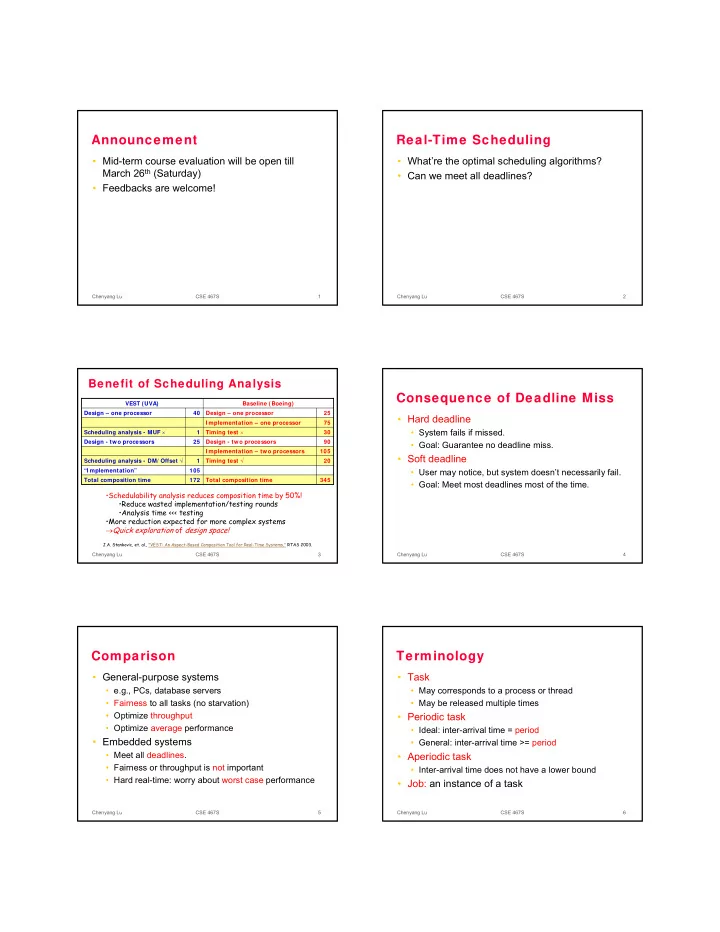

Announcement Real-Time Scheduling • Mid-term course evaluation will be open till • What’re the optimal scheduling algorithms? March 26 th (Saturday) • Can we meet all deadlines? • Feedbacks are welcome! Chenyang Lu CSE 467S 1 Chenyang Lu CSE 467S 2 Benefit of Scheduling Analysis Consequence of Deadline Miss VEST (UVA) Baseline (Boeing) Design – one processor 40 Design – one processor 25 • Hard deadline I mplementation – one processor 75 • System fails if missed. Scheduling analysis - MUF × Timing test × 1 30 Design - two processors 25 Design - two processors 90 • Goal: Guarantee no deadline miss. I mplementation – two processors 105 • Soft deadline Scheduling analysis - DM/ Offset √ Timing test √ 1 20 “I mplementation” 105 • User may notice, but system doesn’t necessarily fail. Total composition time 172 Total composition time 345 • Goal: Meet most deadlines most of the time. •Schedulability analysis reduces composition time by 50%! •Reduce wasted implementation/testing rounds •Analysis time <<< testing •More reduction expected for more complex systems → Quick exploration of design space! J.A. Stankovic, et. al., "VEST: An Aspect-Based Composition Tool for Real-Time Systems," RTAS 2003. Chenyang Lu CSE 467S 3 Chenyang Lu CSE 467S 4 Comparison Terminology • General-purpose systems • Task • e.g., PCs, database servers • May corresponds to a process or thread • Fairness to all tasks (no starvation) • May be released multiple times • Optimize throughput • Periodic task • Optimize average performance • Ideal: inter-arrival time = period • Embedded systems • General: inter-arrival time >= period • Meet all deadlines. • Aperiodic task • Fairness or throughput is not important • Inter-arrival time does not have a lower bound • Hard real-time: worry about worst case performance • Job: an instance of a task Chenyang Lu CSE 467S 5 Chenyang Lu CSE 467S 6
Timing Parameters Metrics • Task T i • Schedulability • A task set is schedulable under a scheduling • Period P i algorithm if all jobs can meet their deadlines • Worst-case execution time C i • Overhead • Relative deadline D i • Time required for scheduling decision and context • Job J ik switches. • Release time: time when a job is ready • Response time R i = finish time – release time • Absolute deadline = release time + D i • A job misses its deadline if Chenyang Lu • Response time R i > D i CSE 467S 7 Chenyang Lu CSE 467S 8 Optimality Optimal Scheduling Algorithms A scheduling algorithm S is optimal if • Rate Monotonic Scheduling (RMS) • Higher rate (=1/period) � Higher priority • a task set is not schedulable under S � it is not • Optimal preemptive static priority scheduling algorithm schedulable under any other algorithms • Earliest Deadline First (EDF) • Earlier absolute deadline � Higher priority • Optimal preemptive dynamic priority scheduling algorithm Chenyang Lu CSE 467S 9 Chenyang Lu CSE 467S 10 Assumptions Utilization Bound • Single processor. • Utilization of a processor: • All tasks are periodic. = ∑ C • Zero context switch time. j U P • Relative deadline = period. ∈ T S j j • No blocking. where S is the set of tasks on the processor. • Utilization bound U b : All tasks are guaranteed • RMS and EDF have been extended to cases with relaxed assumptions to be schedulable if U ≤ U b Chenyang Lu CSE 467S 11 Chenyang Lu CSE 467S 12
Necessary Condition RMS Utilization Bound • U b (n) = n(2 1/n -1) • No scheduling algorithm can schedule a task set if U > 1 • n: number of tasks • U b (2) = 0.828 • U b ≤ 1 • U b (n) ≥ U b ( ∞ ) = ln2 = 0.693 • An algorithm is optimal if its U b = 1 • U ≤ U b (n) is a sufficient condition, but not necessary in general cases. • U b = 1 if all process periods are harmonic, i.e., periods are multiples of each other • e.g., 1,10,100 Chenyang Lu CSE 467S 13 Chenyang Lu CSE 467S 14 RMS EDF Utilization Bound • U b = 1 • RMS may not guarantee schedulability even when CPU is not fully utilized • U ≤ 1 is a sufficient and necessary condition for schedulability. • Low overhead: When tasks are fixed, priorities are never changed Chenyang Lu CSE 467S 15 Chenyang Lu CSE 467S 16 EDF Assumptions • EDF can guarantee schedulability as long • Single processor. as CPU is not fully utilized • All tasks are periodic. • Higher overhead than RMS: Task • Zero context switch time. priorities may need to be changed online • Relative deadline = period. • No blocking. • What if relative deadline < period? Chenyang Lu CSE 467S 17 Chenyang Lu CSE 467S 18
Deadline Monotonic Scheduling (DMS) Response Time Analysis • Shorter relative deadline � Higher priority • Assume fixed-priority scheduling • Optimal preemptive static priority scheduling • Critical instant when relative deadline < period • results in a task’s longest response time. • occurs when all higher-priority tasks are released at the same time as the task. Chenyang Lu CSE 467S 19 Chenyang Lu CSE 467S 20 Response Time Analysis /* Tasks are ordered by priority; T 1 has the highest priority */ for (each task T j ) { I = 0; R = 0; while (I + C i > R) { R = I + C j ; if (R > D j ) return UNSCHEDULABLE; ⎡ ⎤ R ∑ j-1 I= C ; ⎢ ⎥ k P k=1 ⎢ ⎥ k } return SCHEDULABLE; } Chenyang Lu CSE 467S 21
Recommend
More recommend